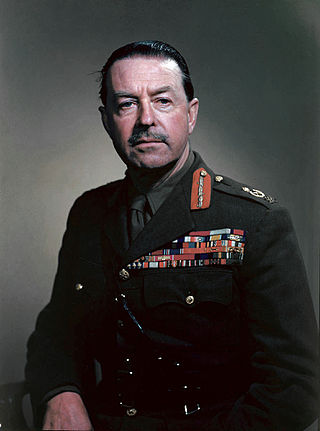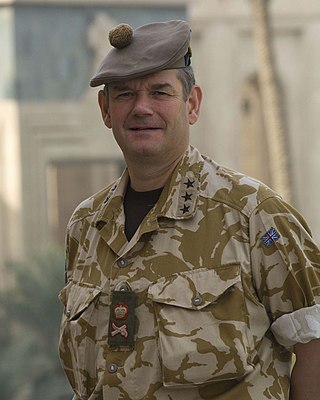Rear admiral is a senior naval flag officer rank, equivalent to a major general or divisional general and air vice marshal and above that of a commodore and captain, but below that of a vice admiral.

Field marshal is the most senior military rank, ordinarily senior to the general officer ranks. Usually, it is the highest rank in an army, and as such, few persons are appointed to it. It is considered as a five-star rank (OF-10) in modern-day armed forces in many countries. Promotion to the rank of field marshal in many countries historically required extraordinary military achievement by a general. However, the rank has also been used as a divisional command rank and also as a brigade command rank. Examples of the different uses of the rank include Afghanistan, Austria-Hungary, Pakistan, Prussia/Germany, India and Sri Lanka for an extraordinary achievement; Spain and Mexico for a divisional command ; and France, Portugal and Brazil for a brigade command.

Marshal of the Royal Air Force (MRAF) is the highest rank in the Royal Air Force (RAF). In peacetime it was granted to RAF officers in the appointment of Chief of the Defence Staff (CDS), and to retired Chiefs of the Air Staff (CAS), who were promoted to it on their last day of service. While surviving Marshals of the RAF retain the rank for life, the highest rank to which officers on active service are promoted is now air chief marshal. Although general promotions to Marshal of the Royal Air Force have been discontinued since the British defence cuts of the 1990s, further promotions to the rank may still be made in wartime, for members of the Royal Family and certain very senior RAF air officers in peacetime at the discretion of the monarch; all such promotions in peacetime are only honorary, however. In 2012, the then Prince of Wales was promoted to the rank in recognition of his support for his mother, Queen Elizabeth II, in her capacity as head of the armed forces (commander-in-chief), while in 2014 Lord Stirrup, who had served as Chief of the Air Staff and Chief of the Defence Staff for over seven years, was also promoted.
Flying officer is a junior officer rank used by some air forces, with origins from the Royal Air Force. The rank is used by air forces of many countries that have historical British influence.
Squadron leader is a senior officer rank used by some air forces, with origins from the Royal Air Force. The rank is used by air forces of many countries that have historical British influence.
Wing commander is a senior officer rank used by some air forces, with origins from the Royal Air Force. The rank is used by air forces of many countries that have historical British influence.
Group captain is a senior officer rank used by some air forces, with origins from the Royal Air Force. The rank is used by air forces of many countries that have historical British influence.
Air commodore is a air officer rank used by some air forces, with origins from the Royal Air Force. The rank is also used by the air forces of many countries which have historical British influence and it is sometimes used as the English translation of an equivalent rank in countries which have a non-English air force-specific rank structure.
Air vice-marshal is a air officer rank used by some air forces, with origins from the Royal Air Force. The rank is also used by the air forces of many countries which have historical British influence and it is sometimes used as the English translation of an equivalent rank in countries which have a non-English air force-specific rank structure.
Air marshal is an air-officer rank used by some air forces, with origins from the Royal Air Force. The rank is used by the air forces of many countries which have historical British influence, including many Commonwealth nations. The rank is usually equivalent to a vice admiral or a lieutenant general.
Flight Lieutenant is a junior officer rank used by some air forces, with origins from the Royal Air Force. The rank originated in the Royal Naval Air Service (RNAS) in 1914. It fell into abeyance when the RNAS merged with the Royal Flying Corps during the First World War but was revived in 1919 in the post-war RAF. The rank is used by air forces of many countries that have historical British influence.
Pilot officer is a junior officer rank used by some air forces, with origins from the Royal Air Force. The rank is used by air forces of many countries that have historical British influence.
Marshal of the air force or marshal of the air is a five-star rank and an English-language term for the most senior rank in some air forces. It is usually the direct equivalent of a general of the air force in other air forces, a field marshal or general of the army in many armies, or a naval admiral of the fleet.

The Chief of the Air Staff (CAS) is the professional head of the Royal Air Force and a member of both the Chiefs of Staff Committee and the Air Force Board. The post was created in 1918 with Major General Sir Hugh Trenchard as the first incumbent. The current and 30th Chief of the Air Staff is Air Chief Marshal Sir Richard Knighton, who succeeded Sir Michael Wigston on 2 June 2023.

Flight sergeant is a senior non-commissioned rank in the Royal Air Force and several other air forces which have adopted all or part of the RAF rank structure. It is equivalent to a staff sergeant or colour sergeant in the British Army, a colour sergeant in the Royal Marines, and a chief petty officer in the Royal Navy, and has a NATO rank code of OR-7. In the RAF, flight sergeant ranks above chief technician and below warrant officer.
Field marshal is a five–star officer rank and the highest attainable rank in the Indian Army. Field marshal ranks immediately above general, but is not in use in the army's current structure. Awarded only twice, field marshal is a rank bestowed on generals for ceremonial purposes or during times of war.
The Indian Air Force (IAF), the aerial component of the Indian Armed Forces follows a certain hierarchy of rank designations and insignia derived from the erstwhile Royal Indian Air Force (RIAF).

Lieutenant general, formerly more commonly lieutenant-general, is a senior rank in the British Army and the Royal Marines. It is the equivalent of a multinational three-star rank; some British lieutenant generals sometimes wear three-star insignia, in addition to their standard insignia, when on multinational operations.

A five-star rank is the highest military rank in many countries. The rank is that of the most senior operational military commanders, and within NATO's standard rank scale it is designated by the code OF-10. Not all armed forces have such a rank, and in those that do the actual insignia of the five-star ranks may not contain five stars. For example: the insignia for the French OF-10 rank maréchal de France contains seven stars; the insignia for the Portuguese marechal contains four gold stars. The stars used on the various Commonwealth of Nations rank insignias are sometimes colloquially referred to as pips, but in fact either are stars of the orders of the Garter, Thistle or Bath or are Eversleigh stars, depending on the wearer's original regiment or corps, and are used in combination with other heraldic items, such as batons, crowns, swords or maple leaves.
Air chief marshal is a four-star air officer rank in the Indian Air Force. It is the highest active rank in the Indian Air Force. Air chief marshal ranks above the three-star rank of air marshal and below the five-star rank of Marshal of the Indian Air Force, which is largely a war-time or ceremonial rank.













